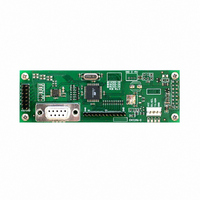VK202-25 Matrix Orbital, VK202-25 Datasheet - Page 11

VK202-25
Manufacturer Part Number
VK202-25
Description
VFD ALPHA/NUM DISPL 20X2 SER/I2C
Manufacturer
Matrix Orbital
Series
VK202-25r
Datasheet
1.VK202-25.pdf
(35 pages)
Specifications of VK202-25
Outline L X W X H
116.00mm x 37.00mm x 29.48mm
Viewing Area
89.75mm L x 11.50mm W
Display Format
20 x 2
Display Type
Character
Format
5 x 7 Dots
Character Size
4.70mm H x 2.40mm W
Interface
Serial
Operating Temperature
-20°C ~ 70°C
Product
Character Display Modules
Character Count X Line
20 x 2
Module Size (w X H X T)
116 mm x 37 mm x 29.48 mm
Operating Temperature Range
- 20 C to + 70 C
Dot Format
5 x 7
Viewing Area (w X H)
89.75 mm x 11.5 mm
Lead Free Status / RoHS Status
Lead free / RoHS Compliant
Voltage - Supply
-
Number Of Dots
-
Lead Free Status / Rohs Status
Details
Other names
635-1020
The power connector on the PC cable is wired as shown in Figure 2-7.
2.1.3 I²C Communications
I²C communications runs at 100 kBps and supports up to 127 units on a single communications line. The
I2C data line operates on 5 volt CMOS levels.
The idea of ACK is to indicate when the data has been received correctly. ACK does not indicate data
incorrectly received. ACK simply fails to indicate when data is correctly received. Clearly, this is of limited
usefulness and even less so with Matrix Orbital modules. Matrix orbital modules are not capable of failing
to acknowledge an incorrectly received byte in response to that bytes transition. They are only capable of
failing to acknowledge the bytes following the byte, which was not received. To fully understand the
reasons for this one needs to understand something about how a Matrix Orbital module processes data.
Basically the reason why a Matrix Orbital module might fail to receive a byte correctly is that it was unable
to process the byte previous before the failed byte was transmitted. Because the module cannot possibly
know that it would be unable to store the byte before the next byte was received it cannot know to not ACK.
The reason for this situation in deference to situations you might be familiar with (i.e. memory chips, etc…)
is that the Matrix Orbital module employs a microprocessor to perform these data storage functions. A
memory chip takes care of these things entirely with in hardware subsystems that operate at the same speed
as the transmission themselves.
The VK202-25 uses a standard Phillips 7bit address as defined by Phillips. How ever, we at Matrix Orbital
specify I
read/write bit. If we take a standard Phillips 7bit address of 45hex this would be in binary 1000101. This is
7bits. If one adds the read write bit to this 7bit address and you assume that you are writing one gets
10001010. Matrix Orbital would describe the Philips I
would be 8Bhex.
For more information on Phillips I
http://www.ping.be/~ping0751/i2cfaq/i2cindex.htm
2.2 General Purpose Outputs
The VK202-25 has six general purpose outputs. These are provided to control relays or other electronic
devices. This allows external devices to be turned on or off using your PC or controller and software
commands. (See sections 6.1.6 and 6.1.7 for the command syntax.)
Each output is wired as shown in Figure 2-8. The + terminal is connected directly to the module positive
supply, the – terminal is connected through a 240 ohm current limiting resistor and the electronic switch to
ground.
VK202-25 rev. 05
2
C address in 8bits. The 8
Pin Number
2
3
5
th
2
C please visit…
bit, least significant bit (LSB or Low Order Bit) of the 8bit address is
Data from LCD
Data to LCD
Direction
-
11
2
C address of 45hex as 8Ahex. The read address
Description LCD Host
Data Out
Data In
Ground
gnd
Rx
Tx
gnd
Rx
Tx
















